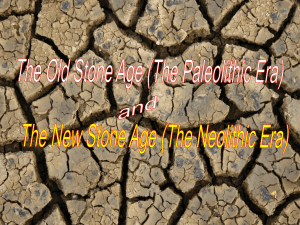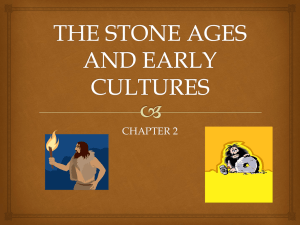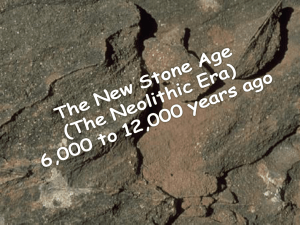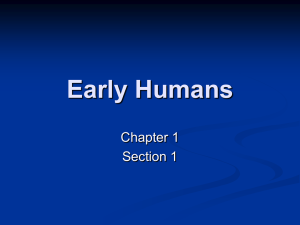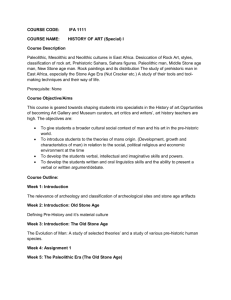Paleolithic and Neolithic Eras.ppt - Nagel
advertisement
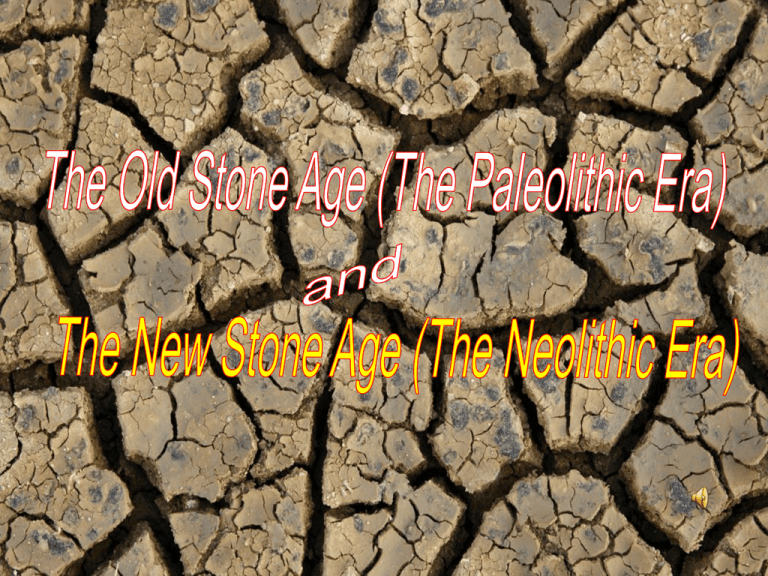
Scientists believe that life began on the continent of Africa 3.6 million years ago…… Neanderthal Cro-Magnon Modern Man Cro-Magnon man early Homo sapiens (the species to which modern humans belong) that lived about 40,000 years ago. Role of Artifacts www.texasbeyondhistory.net/ rubin/images/artif... • Let us know more about ancient cultures • Somewhat limited – theories have formed to attempt to explain the past • The Old Stone Age or the Paleolithic Era, was a period of time that lasted until about 12,000 to 70,000 years ago. •Man survived by hunting animals and gathering roots, berries, leaves, and seeds. •Old Stone Age (Paleolithic Era) people eventually began to hunt in groups. •Cave Art showing men hunting in groups •These antlers may have been used as a disguise during the hunt. •Man used stone, wood, and bone tools to survive during the Old Stone Age. Bow found in Denmark Hand Axe Flint Blades used to sharpen tools Bone Harpoon •using a flint blade to skin an animal •using a flint blade to butcher a carcass There was another important •There was another importantof development – the discovery development – the discovery of fire fire. Many Stone Age people were Nomads, or people who had no settled home. • The New Stone Age or The Neolithic Era lasted until about 6,000 to 12,000 years ago. • During the Neolithic Era, people began to settle in one place. •Man began to change his diet and eat grains and small animals. • Agriculture is the raising of crops and animals. • The development of agriculture began over a long period of time and in more than one place. • People no longer needed to travel great distances to gather food. • People learned how to domesticate plants and animals. • To domesticate means to train something to be useful to people. • Early people learned to care for plants such as wheat, barley, peas, and lentils. • The first farmers also domesticated wild goats, cattle, and sheep. •Ancient charred wheat grains are shown in the picture above. • Man domesticated wild wheat. • Thousands of years ago, an ear of corn did not make much of a meal. (top) • It took thousands of years of careful breeding for ears of corn to reach their present size. (bottom) • People still used stone, bone, and wooden tools, but some new tools were added by using copper and bronze. •These early farming tools date back to around 8,000 years ago. The axe, bottom, was used for clearing; flint sickles, left, were used for harvesting cereal crops; a flat rock and rounded stone, center, were used for grinding flour; and perforated clay slabs, upper right, were probably used to ventilate bread ovens. Prehistory Paleolithic Age – Old Stone Age (Est. 2 mil BC-9000 BC) 1. Hunters & Gatherers A. Nomad: Moving from place to place in search for food. B. Men hunted & fished. C. Woman gathered fruits, nuts, etc. 2. Way of Life A. Cave paintings B. Stone tools & pottery C. Domesticated dogs II. Neolithic Age – New Stone Age (9000 BC – 3000 BC) 1. Farming Neolithic Revolution A. People could remain in one place. B. Herding of animals – goats, sheep & cattle. 2. Community – A. Council of Elders/Chief – made important decisions. B. Warrior class C. Kept possessions. I. Early People Section 1: Studying the Distant Past • Archaeologists study prehistoric times by examining things that early peoples left behind. • The study of fossils has helped archaeologists learn about the lives of the earliest humans. • Archaeological studies suggest that the earliest humans Early People Section 2: Hunter-Gatherer Societies • Hunter-gatherer societies moved from place to place, hunting small animals and gathering plants for food. • The development of tools and the use of fire helped the people in hunter gatherer societies improve their lives. • Modern humans developed the ability to use language, which helped them to survive. Early People Section 3: Populating the Earth • By about 12,500 years ago, modern humans had spread to many regions of the world, including Africa, Asia, Europe, Australia, North America, and South America. • Modern humans adapted to Ice Age conditions by building shelters and making warm clothing. • By forming larger groups, modern humans adapted in order to better hunt and defend themselves. The Beginning of Civilization Section 1: Early Agriculture • Over a long time, hunter-gatherers domesticated plants and animals, and most groups became farmers. • Although the Middle East was the first center of agriculture, farming appeared in several other parts of the world. • Permanent farming settlements developed, and surplus food allowed some people to become crafts workers.
